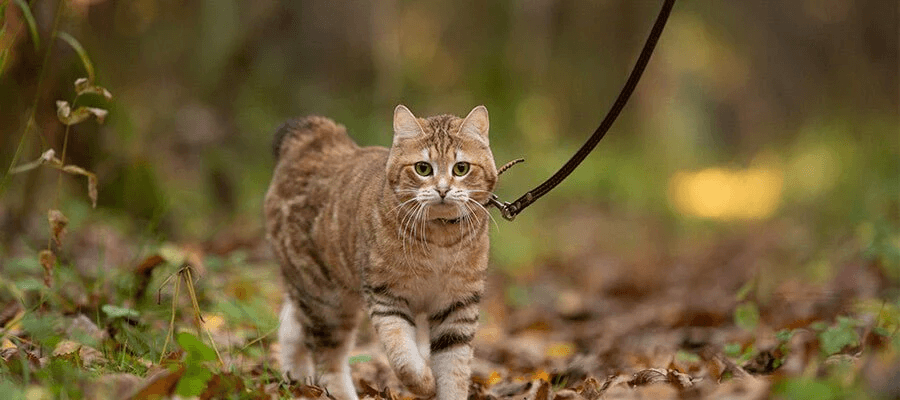There have been quite a few videos surfacing on social media of people taking a cat for a walk, and getting out and about with them. The cats in these videos look as if they’re having a great time. They can be seen in all kinds of different environments from urban to the beach, and just about everywhere else in between!
So, is taking the cat for a walk something you should be doing?
Why you should or shouldn’t take your cat on a walk
Unlike most dogs, cats can get the exercise they require in an indoor environment as long as you supply them with appropriate toys, furnishings and playtime! Investing in a cat tree, or even a cat wheel for a super energetic breed, and spending time playing with wand toys, balls and toy mice can be more than enough for most cats. if you do want your cat to have outdoor space, a secure enclosure can give them safe outdoor access, with no risk to them or the local wildlife.
If you take a cat for a walk, while it might offer the stimulation of being outdoors and extra exercise, the environment is entirely unpredictable, with traffic, people, dogs and wildlife posing a risk.
However, that’s not to say that it's impossible or a bad idea!
Is walking your cat weird?
While it might not be the most usual activity to do with a cat, it’s not weird. Some of the more active breeds, like Siamese, Orientals and Bengals will take well to walking on a lead, and seem to cope quite well with the extra stimulation. Gentler, more timid breeds may not cope as well. It’s important to consider how well your particular cat might take to the activity.
Do cats like walking on a leash?
As mentioned, some breeds, and some individual cats who have outgoing natures, can enjoy going for walks. Forcing a timid or less active cat to walk wouldn’t be kind though, so you should think about who the activity is really for. An enclosure where a lazy cat can sit in the sun outdoors might be a better option in some cases.
How to teach your cat to walk on a lead
If you think your cat would enjoy walks, be aware that teaching a cat to walk on a lead will take time, patience and many gradual steps.
Begin by getting them used to wearing a collar. Start with a little time every day, reassuring your cat and perhaps using treats. Most cats adjust to collars relatively quickly, and it’s a simple step towards getting your cat accustomed to wearing a harness. A simple collar is not really suitable for walking, as a panicked cat will be able to wriggle out of it and you risk losing your treasured pet.
The next step is to invest in a proper harness and lead that’s designed for cats. These come in a range of sizes, and you need one that will be firm, but not tight.
As with the collar training, begin with short sessions indoors with the harness, speaking to them with a ‘happy’ voice, and offering a treat. A very typical response to early sessions with a harness is that the cat will flop over on its side and refuse to move. Don’t panic - this is quite normal.
Try tempting your cat with a toy. Flicking a wand toy your cat usually chases for example can see them jump for the toy before they remember they are trying to show you how awful the harness is!
Once your cat is used to wearing the harness, and is wandering happily around the house in it, you can attach the lead. Initially, your cat will likely take you for a walk, rather than you having any control. With patience, you can encourage your cat with light twitches of the lead and voice commands to walk with you. This can take some time. If you have a safe yard where you can practise outdoors, it’s advisable to spend some time doing that before venturing off into the wider world.
Walking a cat in public spaces is an exercise in risk management. Traffic, people, kids on bikes, dogs off and on leashes are all things you will need to be constantly looking out for, so you can take evasive action, including picking up your cat up.
What’s the best cat walking harness and leash?
The best cat harness and leash is one that is designed specifically for cats. Don’t buy a small dog harness, as the proportions aren’t right for a cat. The Rogz Alley Cat harness and lead set is a good example of what to look for in an appropriate harness and lead.
It has a collar-like strap, with a second strap that fits around the chest immediately behind the front legs. Both are connected to a strap that runs between the cat’s shoulder blades, where you attach the lead. Both straps are adjustable, allowing you to tailor it to fit your cat firmly but comfortably. When well-fitted, this style of harness is the most secure, and offers the safest option for your cat. It also comes in a range of colours, so you can coordinate or contrast with your cat’s coat.
Can you train your cat to walk without a leash?
A cat with whom you are strongly bonded may well follow you closely if you choose to walk it without a harness and lead. Bear in mind though, as is the case with most cat behaviour, it will do that because it chooses to; not because you have any control. It is possible to train some cats to obey commands, but even those who take to it don’t have the inbuilt desire to please that dogs have.
So walking your cat without a lead can be unsafe, especially if your cat is usually kept indoors, or restricted to an enclosure for outdoor time. Going beyond your property with an unleashed cat means you run the risk of losing your cat if something frightens it, and it panics and runs.
If you are planning to walk your cat, it’s safer to train it to a harness and lead.
Want to find our more about looking after your cat? See the other cat-related articles on our website.





























